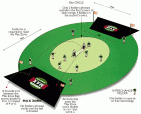Draws in Cricket
Divy Tripathi |
“Doubtful it stood,
As two spent swimmers that do cling together
And choke their art.”
If one were to describe a ‘draw’ in cricket, there won’t be many better images than the one created from the above lines of Shakespeare’s Macbeth. Test cricket is unique as it has four possible results: Win, Loss, Tie and Draw. The difference between a tie and a draw can be explained in the following words: In a tied test both sides can equally lay claim to success in the game, a sort of joint winners without the word ‘winner’ used. If one were to explain this in the context of Limited overs cricket, the Natwest Series final of 2005 ended in a tie between Australia and England and they were deemed to have shared the trophy. (Though this was the situation in simpler times, we have since moved on to the era of Super-Overs)
On the other hand, in a draw both sides have failed to dislodge the other in order to achieve success in the game. It doesn’t matter if the two teams have played out a run-fest on a flat deck or a nail-biting thriller, the result would still be deemed as a draw.
This ‘failure’ could pan out in several forms. Let us take a look at them:
- Plain-ones: The worst of this lot are games washed out by rain, for the little or no cricket that you get can be really frustrating as a viewer. Mostly though, these play out on flatter decks where both sides pile on immense totals and there is little or no chance of a result by the fifth day.
On occasions though, even these can have their moments of entertainment as some of the non-regular bowlers can be given a bowl even getting a wicket at times (Alastair Cook getting Ishant Sharma at Nottingham in 2014) or the teams can try and focus on creating mini-contests in a game which is otherwise, heading towards a certain draw. (Sri Lanka in Chennai Test 2005 finished a rain affected game after taking a lead of one run over India’s first innings effort)
- Decisive Draws: These are those which determine the outcome of a series and thus have a particular value in the eyes of fans. They are usually the final tests of a close series. A comparable situation in Limited overs cricket are the knock-out games, which irrespective of the manner in which they pan-out always garner the maximum eyeballs. The Oval Test in 2005 became valuable because it helped England regain the Ashes. The Sydney 2004 test helped Australia save a series against India.
- The Near Results: Let’s open up towards the more exciting of the lot now. These tests produce some good cricket, with the game open till the end however, the nail-biting contest ends up in a draw. India vs West Indies (2011) at Mumbai and Zimbabwe vs England (1996) at Bulawayo ended with the scores tied but the chasing side had not lost all its wickets. (Otherwise, the game would’ve been a tie) These are fun to watch because they usually feature sides taking risks towards the end of the game, thus opening up possibilities of all four results to the game.
- Twist in the Tale: The games where the conditions and pitch indicate that the match would finish in a particular way, but things take a turn for something else. Could be an excitement on the final day of an otherwise dull test like in 2006 on an extremely flat wicket of Faisalabad, where only 23 wickets had fallen over 410+ overs, Pakistan went from 488-3 to 490-8. This loss of five wickets for two runs was down to some excellent bowling from Zaheer Khan and RP Singh but had little impact on outcome of the game. Another instance is the first Test of England tour of Pakistan 2015, which saw a Pakistani collapse and England left with a chase of 99 runs in the final few overs. The English failure to do the same ensured a draw, but the final day was a stark contrast to the way in which the rest of the test had panned out.
On the other hand, it could also mean a test which seems like it is heading for a certain day 3 or 4 finish being converted into a draw like in Wellington 2014 where India had a lead of 152 runs over New Zealand who had only five of their wickets left in their second innings. Brendon McCullum scored his country’s only triple hundred and Watling and Neesham chipped in an epic fightback which not only took a certain win away from India but also allowed New Zealand to have a go at Indian batters for about 50 overs.
- The Great Escapes: The ‘what-makes-test-cricket-special’ category of draws. Game set on the last day with only one side in sight of victory. And at one point it seems that they have enough overs in hand to enforce that win. It takes a special kind of fight to endure the pressure if your skill-set doesn’t include batting or are injured and have to play out for a draw. In fact, playing out for a draw in itself might muddle a few heads and defensive mindset might lead to collapses. England at Cardiff 2009 with James Anderson and Monty Panesar surviving the crucial last overs, a weakened Australia fighting out to save the test versus Pakistan in Dubai 2018 and the recent Sydney special by Ashwin and Vihari can all come in as examples of the above.
- The Blockathon: South African specialty, but teams with South Africans can do the job as well. (England at Eden Park 2013)
Basically dig in the trenches and bat like your T20 contracts depend on the number of dots you play. South Africa at Adelaide in 2012, Colombo 2014 and even the failed vigils at Capetown 2020 and Delhi 2015, took some special effort and a kind of cricket that includes batting at a scoring rate reminiscent of the middle of the 20th century. Definitely not always the most exciting of tests to watch, unless you are hoping your team pulls off the impossible.





Leave a comment